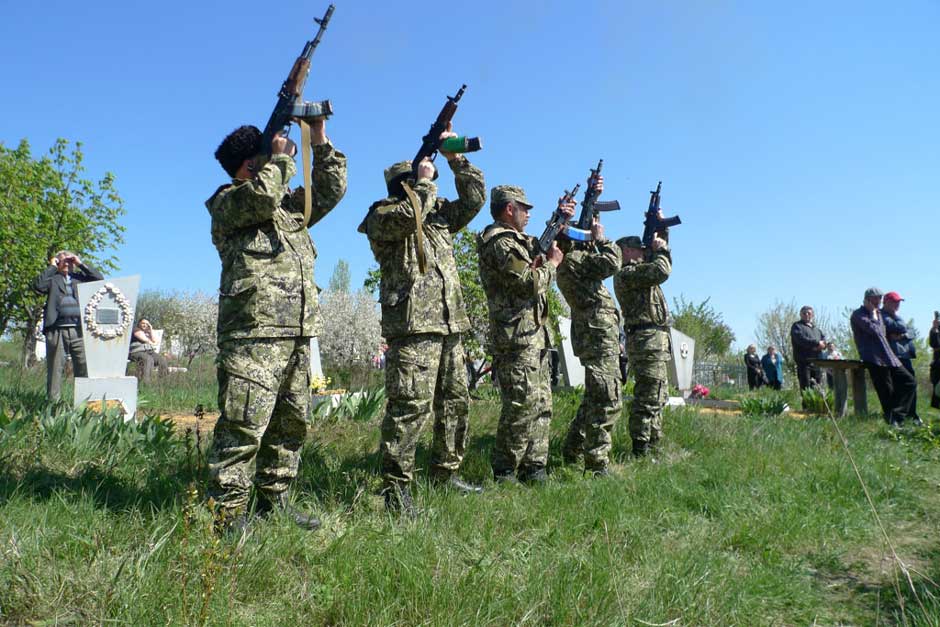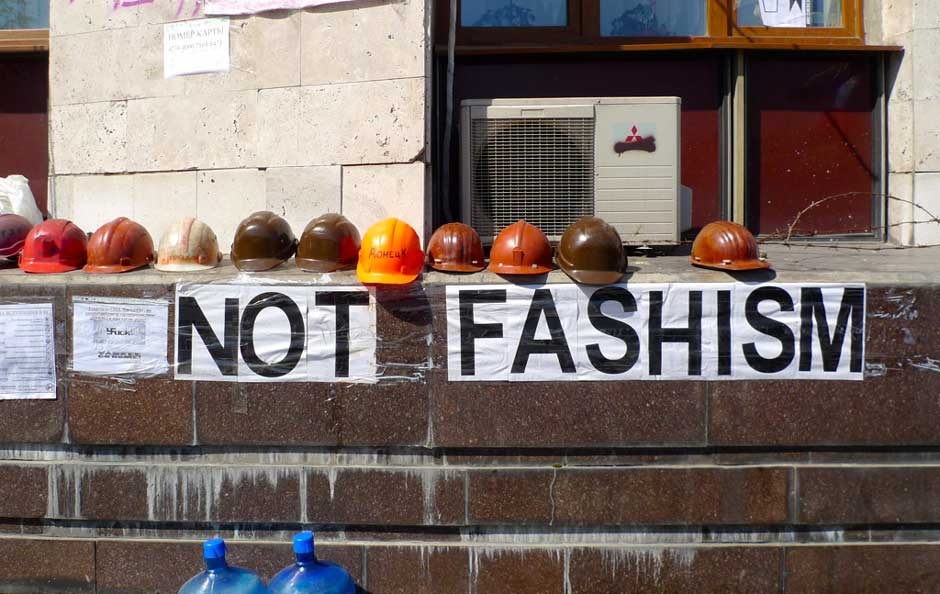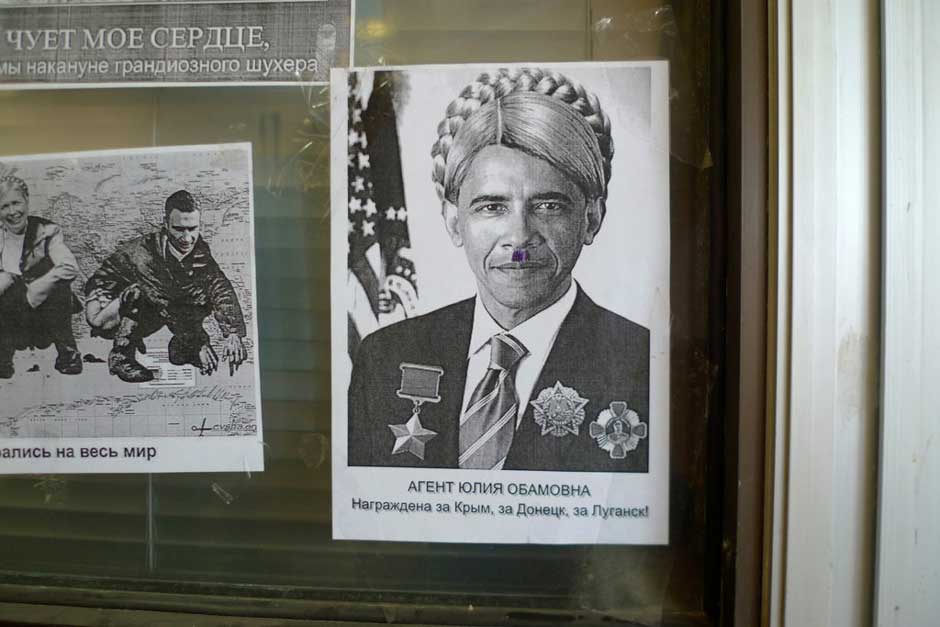From the cemetery in Khrestysche we could see for miles across the valley and the rolling green hills. Men from the village militia pointed to the horizon and said that their enemies were “over there,” somewhere. And then the funeral party came walking up the path from the village, bearing the open coffin of twenty-one-year-old Aleksandr Lubenets. “He was very cheerful. He loved life,” his father, Vladimir, told me. “And then some bastard decided to end it. They shot him in the back.”
Krestysche is on the outskirts of Sloviansk, in eastern Ukraine. Aleksandr and two of his mates, were part of the local rebel militia, which has been ringed by anti-government barricades for the last few weeks. What exactly happened is unclear. Yevgeniy, the commander of Aleksandr’s group, said, “He wanted to be a hero.” On April 24, the three friends ran into Ukrainian soldiers or police and that was the end of it.
On the same day, in the nearby town of Gorlovka, forty-two-year-old Volodymyr Rybak was buried. A policeman turned local councilman, he remonstrated with the men who had put up a rebel flag in town. A few days later he and a man later identified as a student from Kiev were found in a river near Sloviansk. Rybak’s body, which had been weighted down with a bag of sand, showed signs of torture. As mourners came to pay their respects at his home in Gorlovka, Elena, his widow, sat by his open coffin stroking his face.
If war is coming, which is the way it feels, Aleksandr and Volodymyr will be remembered and not just by their families and friends. When the Balkan conflict began in the early 1990s the names of the very first to die were engraved in everyone’s memory and later in the history books. Soon after, the individual names and faces gave way to the torrent of numbers.
In many ways the beginning of this conflict in eastern Ukraine resembles that of the beginning of the Yugoslav wars. But the similarities are superficial. As the rebels in Khrestysche—who are variously described as “pro-Russian” or “separatists” or, by the Ukrainian authorities, “terrorists”—scanned the horizon before firing their salute over Aleksandr’s grave, I was struck by the crucial difference. In the Balkans, the men would point to the next village and tell you how they had come to kill us in 1941 and how we are not going to let them do it again. In eastern Ukraine there is no ethnic basis for strife, but hate is still being manufactured. Almost everyone speaks Russian, but you can describe yourself as Russian or Ukrainian along a sort of spectrum. Nor, in contrast to the Balkans, do religious differences play a part. Almost everyone is Orthodox.
Talk to people manning the anti-government barricades and taking part in the demonstrations against Kiev here, however, and one thing in particular is scary. After a day or two you realize that they all say more or less the same thing. “We want to be listened to,” people say. The government in Kiev, which took power after the pro-European revolution there, is a “fascist junta” backed by Europe and the US.
It is as though the Russian media—which is widely watched and read here—has somehow embedded these messages into the heads of people and they have lost the ability to think for themselves. Those who are angry talk as though they were a long persecuted minority, as if they have forgotten that easterners under former president Viktor Yanukovych ran the country until February. Everyone here has been robbed blind by politicians in a system that was as corrupt as can be, but all that seems to be registering right now is a nationalist and hysterical drumbeat from Russia about the new Nazis of Kiev and their NATO masters.
This is ominously reminiscent of what the Serbian media and other bits of the former Yugoslav media did when Yugoslavia collapsed. Then, Serbs were subjected to endless documentaries about Croatia’s wartime fascists, whom they were told were coming back. Now the Russian media says the fascists have returned. And of course, just as there were indeed then some admirers of Croatia’s wartime fascists, there are some right-wing nationalists in Ukraine now; the big lie is to give them a significance they simply don’t have. Speaking to people in eastern Ukraine makes me recall what Milos Vasic, the great Serbian journalist, used to say in 1991: if the entire mainstream US media were taken over by the Ku Klux Klan it would not take long before Americans too would become crazed.
Advertisement
No big surprise then that on April 27 and 28, in Donetsk, the regional capital, rebels seized control of the local TV building and transmission facilities, turned off the Ukrainian channels, and tuned in to Russian ones. On them people could see Russian journalists, called in the middle of the night to the seized security service building here in Sloviansk, interrogating three captured men said to be from the Ukrainian security services. The men are in their underpants, blindfolded and bloodied. They appear to have been beaten up and to need medical attention. One day this video will almost certainly feature in a war crimes or similar trial, as the local militia commander is present.
Whoever is at the end of the chain of command—and there is little doubt that ultimately it is Vladimir Putin—the vast majority of rebels are locals. They have help from volunteers who have come from elsewhere and a crack mobile team of disciplined and experienced soldiers. In the meantime, the situation throws up all sorts of people who are having the time of their lives. Suddenly what they are doing has meaning and they feel like they are taking part in something great, worthwhile, and historic.
Yekaterina Mihaylova runs the press office of the self-proclaimed People’s Republic of Donetsk. She used to be a journalist. I asked her why the rebels used so many Soviet-era flags and posters. Echoing Putin, she said that the collapse of the USSR was a geopolitical catastrophe and that it had resulted in an artificial border between Ukraine and Russia. When our conversation turned to Soviet history, she said that Ukrainians should be grateful for Stalin because he had created the Ukrainian Soviet republic out of diverse bits of territory and this had subsequently become the first Ukrainian state in history. I asked her about the Ukrainian famine of 1932–1933, in which some 3.3 million people are estimated to have died. “The legend of the Holodomor,” she said, using the name given to it here, was created in Canada by fascist Ukrainian exiles. On Stalin’s Gulags she said, “that story is like Snow White, or…”—and at this point Ludmila, who was translating for me, stumbled, looking something up on her iPhone translator—“‘Thumbelina?’ Do you know what that is?”
I got the impression that some in Mihaylova’s office thought that maybe she had gone a bit far. Viktor Priss, a twenty-eight-year old IT systems administrator, was not a famine-denier. He said that the issue was whether one believed it was created on purpose to target Ukrainians as a nation, or whether Ukrainians were simply its biggest victims which is a respectable argument to have. But Stalin, he went on to say, came to power because it had been “the will of the people to create a dictator.”
At a pro-Ukrainian rally across town I met an artist called Olena Yemchenko, aged forty-two. A few days later she showed me some of her canvasses including ones of busty, headless women adorned with the old election catchphrases of the now deposed president Yanukovych: “prosperity” and “stability.” She said that the women in her picture represented her view that in Ukraine only 10 to 15 percent of people actually think, while everyone else “just exists.” She added however that maybe this was the same in the rest of the world.
Yemchenko showed me photos from exhibitions she had organized, and complained of corruption. She and her colleagues received a grant from the ministry of culture last year for an exhibition but most of the money never arrived because it was stolen. However, Yemchenko explained how she had dealt with this problem. She had a “fatcat” client, who she implied was making his money in some corrupt way. “My task is to take his money and use it wisely,” she said. Some of these funds she used to live off, but the rest was put into supporting the exhibition. In that way she was part of a money-laundering chain, but in her case the cash went back to where it was supposed to have gone in the first place. “For my whole life,” she said, “people have been robbing us.”
One way or another, most of the people in the towns and villages around Donetsk that I have met over the past few weeks feel that way. Rebel or artist, pensioner or miner, everyone feels cheated. So, when someone decides it is in their interest to exploit this resentment, to stir up hatred among people who are angry and often confused by garbled, nationalistic historical narratives of whatever side, then people like Aleksandr and Volodymyr start to die. Families are ripped apart and the violence takes on a logic of its own. That is what is happening in eastern Ukraine today.
Advertisement





